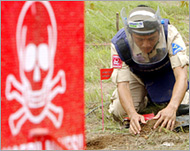African rats boost demining drive
Known for their fine sense of smell, giant African rats have become the latest weapon in the global effort to clear landmines.

“Currently, a fully trained platoon of African Hamster rats, brooded and raised in Tanzania, is engaged in the process of demining,” Frank Weetjens, who manages Mozambique’s mine-detection programme non-governmental organisation, APOPO, said.
“Rats have a very strong sense of smell, which assists them to trace the scent of explosives,” he said.
Unlike mine-sniffing dogs, which easily get bored or by mistake get blown up due to their weight, and unlike metal detectors that cannot differentiate between metal and mines, rats enjoy twitching their noses on the ground for any smell of explosives.
Simple rewards
Rats, rewarded only with bananas and peanuts, undertake monotonous, repetitive tasks for longer periods than dogs that want more affection but easily get bored.
|
“Rats have a very strong sense of smell, which assists them to trace the scent of explosives” Frank Weetjens, |
“Another significant advantage of rats is that they are easily deployed in large numbers due to their small size, light weight, and the fact that one trainer can work with many animals, whereas a dog-handler will usually work with only one or at the most two dogs,” Weetjens added.
Mozambique’s devastating civil war ended more than a decade ago, but field officers have in recent years uncovered thousands of anti-personnel mines that have killed and injured an unknown number of people.
“The rats are very efficient because they are too light to activate anti-personnel mines and work single-mindedly, and on detecting the smell of explosives, they use their forepaws to vigorously scratch on the ground,” Weetjens added.
Efficient tool
Demining experts in Nairobi, where hundreds of delegates gathered this week for the first review of the 1997 Ottawa Convention, explained that rats are numerous in sub-Saharan Africa, are easy to trap and do not succumb to parasitic ailments common in African terrains.
 |
|
Thousands of landmines have |
“They can move across minefields better than men armed with metal detectors,” a Kenyan army official, who took part in demining operations along the Ethiopian-Eritrean border, said.
Despite the efficacy of the rats internal vapour-detection system, normal detection – that is, men rigged out in chest-to-groin Kevlar jackets and armed with metal detectors – remains the most preferred form of demining.
“It is a stereotype, but rats have proved to work better and pose little danger,” a conference delegate said.
Detection of mines by means of metal detectors can be painstaking to the deminer, especially when it cannot distinguish landmines from metals, because in areas where mines have exploded or are littered with metal casings, false signals pose a daunting problem.
Rats in training
In Tanzania’s Sokoine University of Agriculture another group of 60 rats is being trained to join the 24 others that are currently active in Mozambique.
|
“They can move across minefields better than men armed with metal detectors” Kenyan army official |
The Mozambique project and the Tanzanian programme are both funded by the Belgian government, the EU and Geneva International Centre for Humanitarian Demining.
“The rats could complement demining activities in Angola, Eritrea, Ethiopia, Sudan and other mine-effected countries,” Tanzanian Defence Minister Philemon Sarungi told delegates to the landmine conference, which ended in Nairobi on Friday.
With a grant from the World Bank, APOPO has also developed a cheaper method of detecting tuberculosis, compared to the current expensive and time-consuming technology.
“The rats have analysed spatum samples provided by patients from hospitals and health centres in the Dar-as-Salaam region,” Weetjens explained.
“A team of eight specialised technicians can analyse up to 160 samples a day, whereas a trained rat can analyse the same amount in 20 minutes. This is a very significant development, especially in light of the Aids pandemic,” he added.